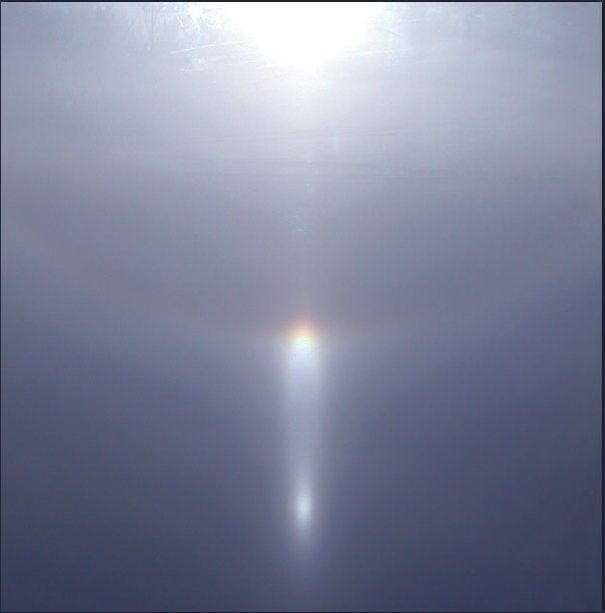Below Horizon Halos
Below Horizon Halos: A Captivating Atmospheric Phenomenon
When it comes to atmospheric optics, there are a plethora of enchanting phenomena to explore. One such phenomenon is the occurrence of halos below the horizon. These mesmerizing displays of light are formed by ice crystals in clouds beneath our line of sight. While most halos are commonly observed around the sun or moon, below horizon halos offer a unique and captivating twist to the spectacle.
Unveiling the Intricate Beauty
Imaging by Tim Stone over Tennessee, we can witness the breathtaking beauty of below horizon halos. The prominent feature in the image is the familiar 22° halo, gracefully curving across the sky. However, what truly sets this scene apart is the presence of additional phenomena. Touching the 22° halo is a narrow lower tangent arc, caused by horizontal column crystals. Its wings elegantly point downwards, eventually converging to form a subsun that mirrors the plate crystals. This interplay of various halos creates an intricate and awe-inspiring sight.
The Mechanics of Below Horizon Halos
Below horizon halos are formed by ice crystals in clouds located beneath the observer's position. These ice crystals act as tiny prisms, bending and refracting sunlight to create stunning optical effects. As light passes through these crystals, it undergoes multiple reflections and refractions, resulting in the formation of distinct halos.
Exploring Different Types of Below Horizon Halos
Below horizon halos encompass a diverse range of optical phenomena. Some notable examples include:
- Lower Tangent Arcs (LTAs): These arcs appear as extensions of the 22° halo, touching its lower edge. LTAs are formed by horizontally-oriented column crystals, which bend light at specific angles to create this unique halo.
- Subsun: The subsun is a mirrored reflection of the sun below the horizon. It is formed by plate crystals, which reflect and refract sunlight in such a way that it appears as a bright spot beneath the observer's position.
- Supralateral Arc: This halo appears as an arc extending from the 22° halo, curving upwards. It is caused by plate crystals, which refract sunlight at specific angles to create this mesmerizing arc.
- Parhelic Circle: A complete circle of light parallel to the horizon, resulting from the reflection and refraction of sunlight by horizontally-oriented ice crystals.
Factors Influencing Below Horizon Halos
Several factors contribute to the formation and visibility of below horizon halos:
- Elevation of the Sun: The position of the sun below the horizon plays a crucial role in determining the appearance of below horizon halos. Different elevations can result in varying halo shapes and intensities.
- Type and Orientation of Ice Crystals: The type and orientation of ice crystals present in the clouds also impact the formation of below horizon halos. Different crystal shapes and orientations create unique optical effects.
- Cloud Thickness: The thickness of the cloud layer can influence the visibility of below horizon halos. Thicker clouds may obscure or enhance the appearance of these phenomena.
Capturing the Magic: Photography Tips
To capture the mesmerizing beauty of below horizon halos, consider the following photography tips:
- Choose the Right Equipment: Use a DSLR camera with a wide-angle lens to capture a larger portion of the sky.
- Time of Day: Optimal conditions for below horizon halos usually occur during sunrise or sunset when the sun is close to the horizon.
- Location: Find an open area with unobstructed views of the sky to capture the full extent of these captivating halos.
- Patience and Persistence: Atmospheric phenomena are ephemeral by nature, so be patient and persistent in your quest to capture the perfect shot.
In conclusion, below horizon halos are a captivating and enchanting aspect of atmospheric optics. These optical phenomena, formed by ice crystals in clouds beneath our line of sight, offer a unique twist to the traditional halo displays. Understanding the mechanics and factors influencing their formation allows us to appreciate the intricate beauty of these phenomena. So, keep your eyes to the sky and be prepared to witness the mesmerizing dance of below horizon halos.

Below Horizon Halos
Imaged by Tim Stone (images) over Tennessee. ©Tim Stone, shown with permission.
All these halos are below the horizon, formed by ice crystals in clouds beneath the aircraft. The familiar 22° halo curves across the image. Touching it is a narrow lower tangent arc produced by horizontal column crystals. The LTA's wings point down to join a subsun mirrored by plate crystals. The HaloSim ray tracing simulation is for a sun elevation of 15°.

Note: this article has been automatically converted from the old site and may not appear as intended. You can find the original article here.
Reference Atmospheric Optics
If you use any of the definitions, information, or data presented on Atmospheric Optics, please copy the link or reference below to properly credit us as the reference source. Thank you!
-
<a href="https://atoptics.co.uk/blog/below-horizon-halos/">Below Horizon Halos</a>
-
"Below Horizon Halos". Atmospheric Optics. Accessed on November 22, 2024. https://atoptics.co.uk/blog/below-horizon-halos/.
-
"Below Horizon Halos". Atmospheric Optics, https://atoptics.co.uk/blog/below-horizon-halos/. Accessed 22 November, 2024
-
Below Horizon Halos. Atmospheric Optics. Retrieved from https://atoptics.co.uk/blog/below-horizon-halos/.